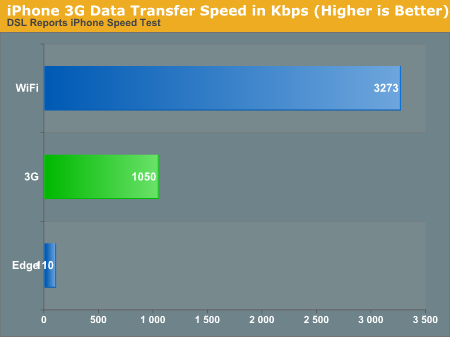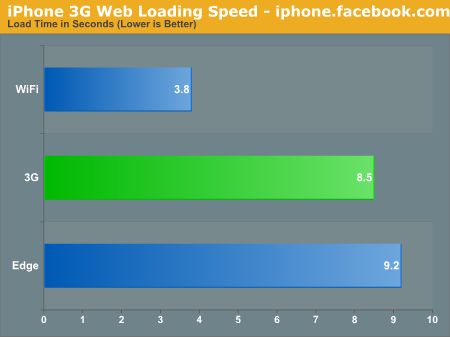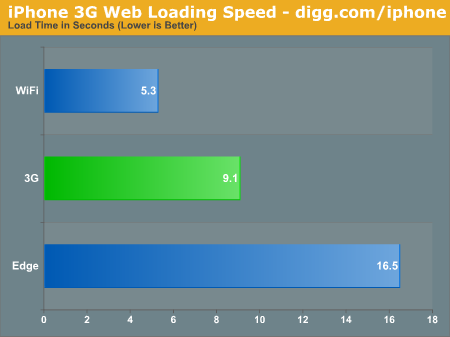Anand Reviews the Apple iPhone 3G
by Anand Lal Shimpi on July 16, 2008 8:00 PM EST- Posted in
- Smartphones
- Mobile
3G Performance
The first thing I did after getting the iPhone 3G was to run a 3G performance test on it. I published my findings immediately.
I’m pretty sure that I can answer the “should I upgrade my iPhone?” question in this page alone, so let’s practice being succinct!
Without a doubt 3G is a lot faster than Edge on the iPhone, but it’s worth setting proper expectations; here are the raw numbers:

Edge will download at around 110kbps, 1Mbps for 3G and 3Mbps for WiFi. Fast enough for web browsing, right? Wrong.
Let’s look at some real world tests:

I loaded the iPhone optimized Facebook home page, on Edge it took 9.2 seconds, 8.5 seconds on 3G and 3.8 seconds on WiFi. What’s interesting is that the initial connection to the server seems to take much longer on both Edge/3G than on WiFi. I originally hypothesized that this may be a DNS issue on AT&T’s network, but even visiting sites using their IP address alone showed the same lag before the page started loading. I’ve seen this as long as I’ve had an Edge capable phone, so it’s not an iPhone specific issue - but it does eat into the usefulness of 3G.
Next up was Digg’s iPhone optimized site:

Here 3G offers a more significant performance advantage, but it still takes around twice as long to render a page as WiFi. Again, I suspect that the problem here is the initial connection to the server.
Finally we have a image heavy site, a little hardware website called AnandTech:

With an image heavy website we’re bound more by download speed than by latency, so while Edge took 45 seconds to load, 3G only took 17 seconds, and WiFi barely had an advantage at 13.5 seconds.
If the majority of sites you use on your iPhone are small, text heavy sites, then you honestly won’t notice a huge difference between Edge and 3G, and it won’t feel like WiFi anywhere to you. However, if you use sites with more images and content to download, 3G will feel more like WiFi and Edge just won’t cut it.










55 Comments
View All Comments
buckdutter - Friday, August 22, 2008 - link
AT&T's coverage could indeed be better, but then again they are still rebuilding from when they decided to switch from TDMA to GSM, instead of following the natural path to CDMA, which Verizon, Sprint, and Alltel (soon to be Verizon) use, as well as many more localized carriers. The problem with CDMA is that it is going nowhere. The majority of the world is GSM, and CDMA is becoming more and more marginalized, in fact in the next 4 or 5 years CDMA will be practically phased out in the US. Verizon (and Alltel) will be switching to LTE, a GSM based technology which will be a rough transition - either resulting in sacrificed coverage, or more expensive devices (like Verizons expensive "world edition phones") that will run on both their networks. Either way, they will be doing what AT&T (Cingular, whatever) did 4 or 5 years ago, and much later in the game.Meanwhile AT&T will make a natural transition from their 3G, which is in all fairness not nearly as widespread as EVDO at the moment, to LTE. Sprint will be going WiMax. Not one major carrier in the US or abroad has made a commitment to the future of CDMA. Verizon has held on to EVDO as long as it could, and has prolonged having to switch, but they are beginning to hit the limitations of EVDO, meanwhile 3G is just getting started, with AT&T planning to follow suit of carriers abroad and boost the speeds to around 20mbps in mid-2009. EVDO will be topping out around 3.2 at most, if even that.
While having used all the services I strongly disagree with saying that Sprint or T-Mobile even come close to AT&T for coverage, it is largely regional subjective, and is really not fair to work in experiences in one localized area into the review for the phone. Like them or hate them, AT&T recognized early that GSM was the roadmap to go. Like it or hate it, blame Verizon for delaying the inevitable for so long...it makes no sense for Apple to make a CDMA phone when it is so limited in implementation globally. Because of that decision they are the most widespread GSM provider in the US (the US was a little late in getting into the GSM game).
In the end, AT&T may have a lot of ground to cover, but we should be excited what at least one U.S. carrier took the leap and is building out a GSM network in the states, even though it meant making the sacrifice of less coverage in rural areas as they build the new network out. It will be interesting to see how Verizon copes with having to change over.
Hrel - Tuesday, August 12, 2008 - link
Over 2 years the new iphone plane costs an extra 60 bucks, but the upfront cost is 300 dollars less. The iphone 3G is less expensive in every way; even with the incremental increase in contract cost. I'm confused that I need to point this out considering you say it in your article then contradict yourself by saying the old plan and phone was less expensive. Total cost over two years the new one is 240 dollars less.maxnix - Thursday, July 31, 2008 - link
With no user replaceable battery, it is a toy, not a reliable business device.It seems to me that 90% of the users I see are fiddling about on it with their fingers and not even 10% use Bluetooth. Are there still no voice driven commands? That's how I use my phone.
Seems like a great device for someone who wants to make calls on their iPod when they are not listening to a lossy audio source.
Jobs is the new PT Barnum in that he fully exploits the "A sucker's born every minute..." credo. The world is full of lemmings.
maxnix - Thursday, July 31, 2008 - link
Welcome fanboys to AT&T's limited 3G. The rest of the world has been there for 5 years.Lezmaka - Monday, July 21, 2008 - link
I think there's a fairly obvious (to me anyway) reason why the talk time measured is almost half the time the specs state, beyond the best case scenario stuff.In most conversations, there's a significant amount of dead air. Even if it's only 1/10 - 1/4 of a second at a time, over the course of several hours, that will add up. But with most music, there's almost no dead air. Even when the person isn't saying something, there's at least some sound being generated. Detecting that dead air and not transmitting would probably be the best for battery life, but even if it continually transmits, the compression would reduce the amount of data transmitted to almost nothing.
I would guess that choosing an audio source that more closely matches an actual conversation would provide a somewhat more accurate test result. But I'm not expert, so what the hell do I know?
Giacomo - Monday, July 21, 2008 - link
Ehm... No man, there's no way this could influence battery life. No matter how intense is the information in the call, most of the energy drain is due to the "line" itself... Keeping the full-duplex conversation online.Everything else left to the battery is the loudspkeaker consumption... But it's a ridicolous amount, you won't be able to measure its impact.
Giacomo
donhoffman - Tuesday, July 29, 2008 - link
Actually the original commenter on this was correct. This is a time-honored technique for getting more battery life out of cell phones. Channel allocation for voice calls is done at call setup. A continuous data stream is not needed to keep up the "line". If either end of the call has nothing to send, it does not need to transmit, saving significant power. The technique used in this article probably does underestimate the battery life. Not by 100%, but maybe 20-30%. Transmit power is much larger than audio power. That is why you get 24 hours listening to music on the iPod side, but only 5 or so hours doing cellular phone calls.nichomach - Sunday, July 20, 2008 - link
Not wishing to get into whether the new iPhone is all that, I'd note that the enforced PIN code when using Exchange is usually a policy setting defined in Exchange, and there's a choice about enabling it. That choice'll be made by your Exchange admin(s). If they enable it - personally, I do - then I'd expect it to be enforced on any device that claims to support Activesync. One of my arguments with Nokia's Mail for Exchange client, for instance, is that it doesn't (or didn't) properly support policies like that; that the iPhone does makes it a viable choice if I end up with a director demanding one. If you're using your phone in a corporate environment, then you may be sending and receiving confidential stuff. Enforcing a PIN and supporting remote wipe properly is the sine qua non as far as I'm concerned.Schugy - Sunday, July 20, 2008 - link
Openmoko will have the best 3rd party support while Nokia and Google (Maemo / Android) have their own ressources. But regarding their openness they are evil. The FIC Freerunner is a nice phone but the Openmoko project still has to develop a lot.On the other hand I think that a Open Pandora handheld with a USB HSDPA modem (maybe builtin in future revisions) is a lot more usable and even has game controls. Telephony and navigation could be done via a bt headset+voip and gps receiver.
All the platforms will feature ports of killer apps like pidgin IM, scummvm, evolution e-mail and lots more. Ports of gnash, the GNU flash player, are possible too but I would suggest to get rid of these stupid and annoying banner ad players. A nice stream or download link for mp4-files will make your full featured (fullscreen / post processing filters) mplayer happy.
cleviticus - Saturday, July 19, 2008 - link
A basic one-line plan with Cingular (I know they go by AT&T now)without ANY extra features runs you $45/month and that is with just enough minutes to tell people that you'll call them back after nine. Unlimited internet and data runs $45, last I checked, and that somehow doesn't cover much texting, something I do a lot of. Texting is another $10. So to get service and data BEFORE tax you spend $90. My provider offers unlimited voice/data/text/GPS/e-mail for $100 with coverage that exceeds AT&T's.That fact alone is enough to keep me away from the iphone for good. I admit that the interface is unbeatable but the functionality of the phone is not. That being said I don't think it deserves as much attention as it receives. Also coverage varies drastically from city to city. In NY my phone works great but in Vegas it blows. In Chicago I'm golden but anywhere between Arkansas and Virginia- forget about it. I used cingular for two years and their coverage was only good in large metropolitan areas. As soon as I got out of the inner city my reception was weak and I couldn't even text. I think they are a horrible company but since they bought up most of the old bell empire- they're here to stay.